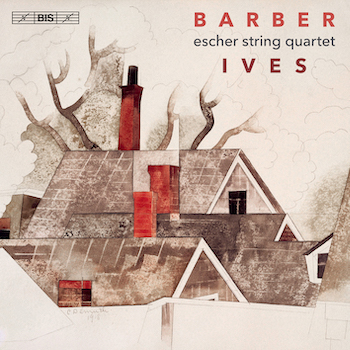Classical Album Review: Escher String Quartet — Barber & Ives String Quartets
Here is an outstanding recording from the Escher String Quartet of music by two stylistically divergent 20th-century American composers, Samuel Barber and Charles Ives.
By Jonathan Blumhofer

Barber’s String Quartet dates from 1936, when he was just twenty-six. While the larger piece is not central to the quartet repertoire, its slow movement — later reworked by Barber as the Adagio for Strings — stands among the most familiar (and loved) compositions of the 20th century.
To hear those pages in their pared-down, original context is satisfying. By nearly any measure, Barber’s Quartet is a strong piece. Its first movement is taut and motivic, kind of like something Bartók might have written, minus the edgy dissonances and folk music inflections. The soaring second movement provides a powerful contrast.
Apparently, Barber was dissatisfied with his efforts at a third movement so, after toying with a two-movement form for the quartet, he opted for (essentially) a short recapitulation of material from the first movement to close out the piece. This makes for a rather jarring listen (which, perhaps, helps explain why the full Quartet hasn’t been more widely embraced).
On their recording, the Eschers include this brisk, Scherzo-like finale as well as the original last movement Barber had omitted. Heard in this order, Barber’s original idea for ending the piece sound better than his later one. To be sure, the mix of fleet and elfin materials in the discarded last movement, as well as the music’s bright peroration, combine for a conspicuously effective ending — particularly in the fresh, singing interpretation the Eschers offer up here.
Ives’ Quartet no. 1 also has something of a checkered history. A deft reworking of various hymn tunes, it was finished around 1909 but only premiered in 1943. At the time of the first performance, Ives opted to remove the fugal first movement (which he had since adapted as the third movement of his Fourth Symphony); when the score was published in the early ‘60s, though, the movement was reinstated on the advice of Ives scholar John Kirkpatrick.
The Eschers play Kirkpatrick’s version and they deliver a blazing, purposeful performance of it. Clearly, their account is rooted in their knowledge of Ives’ mature voice: the Quartet’s dissonances, weird rhythms, odd phrasings, and so on are all drawn out, yet they’re never underlined too heavily. Indeed, while the music’s harmonic pungencies have plenty of acid (especially in that otherwise chaste first movement), its lyricism floats, while the score’s dancing and marching lines are invitingly vigorous and driving.
So it is (more or less), with the album’s filler: Ives’ brash, feisty Holding Your Own and his String Quartet no. 2.
Completed in 1915, the latter could hardly be more stylistically different than either the Quartet no. 1 or the Barber. Its three movements revolve around the concept of “[four] men – who converse, discuss, argue (in re “Politick”), fight, shake hands, shut up – then walk up the mountain side to view the firmament!” In other words, it’s a thoroughly idealistic Ivesian vision of humanity and the divine, cheek by jowl.
His writing in it clearly anticipates some of Elliott Carter’s mid-century ideas about chamber music as a conversation between several equal voices. The music further incorporates echoes of Beethoven, as well as snatches of several hymns and patriotic songs. If the Quartet doesn’t hold together as successfully as the Piano Trio, Orchestral Suite no. 2, or Concord Sonata, that owes more to its meandering musical arguments, diffuse structures, and some unflattering writing for strings (like the stratospheric first violin line at the zenith of the finale) than anything else.
Either way, the Eschers play the daylights out of it, balancing the Quartet’s rhythmical and textural complexities (especially over the first two movements) with breathtaking care. The finale’s transcendent opening benefits from a rich, wide dynamic range and Pierre Lapointe’s execution of its double-stop viola solo is nothing short of astounding.
Jonathan Blumhofer is a composer and violist who has been active in the greater Boston area since 2004. His music has received numerous awards and been performed by various ensembles, including the American Composers Orchestra, Kiev Philharmonic, Camerata Chicago, Xanthos Ensemble, and Juventas New Music Group. Since receiving his doctorate from Boston University in 2010, Jon has taught at Clark University, Worcester Polytechnic Institute, and online for the University of Phoenix, in addition to writing music criticism for the Worcester Telegram & Gazette.
